No products in the cart.
Two Horses, Seven Mules
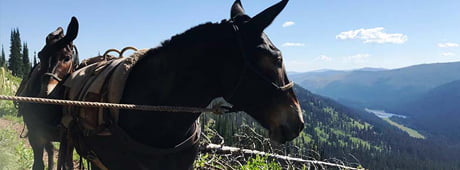
Packing into the Wilderness
Story and Photos by Levi Armichardy
I wake at 4 A.M. to the sound of my dad moving around the one-room cabin. A click of a lighter, and then the space is dimly illuminated by the yellow glow of a propane lantern. I dress by its light, stuff my sleeping bag, roll up my foam pad, and fold up my cot. On the other side of the small room, Dad makes breakfast on a propane stove: coffee for him and homemade pre-wrapped breakfast burritos for both of us.
I step outside. The stars still shine brightly in the early morning darkness, and the cool air, tinged with the scent of cedar trees, awakens me fully. The river roars in the background.
As I return inside, I feel a familiar excitement building. It’s summer of 2022 and I’ve experienced this day sixteen times in my eighteen years on Earth. Many things have changed in that time, yet my excitement remains the same. It grows and energizes me as we eat breakfast. We clean up and do a final sweep of the cabin. All is in order. We lock the door and head down to the loading dock, where the action begins.
Today is one of the best days of the year for me, right up there with Thanksgiving and Christmas. We’re going to Moose Creek, one of my favorite places on the planet, a place that feels like home. Moose Creek is a Forest Service ranger station and airstrip in the middle of the Selway–Bitterroot Wilderness, twenty-five miles from the nearest road.
It sits at the confluence of the Selway River, a designated Wild and Scenic River, and Moose Creek, a major tributary that nearly doubles the volume of the river. To get to the station, my dad and I will ride horses—and lead a string of mules loaded with gear and supplies—twenty-six miles on a trail along the river.
My family first came to the area when I was one. Dad was hired as the packer for the Moose Creek Ranger District, transporting materials through the wilderness via mule and horse. My mom, grandma, and I backpacked in to visit him. Actually, they did the backpacking—I rode in my mom’s pack. They fell in love with the place, and the next year they volunteered as station hosts for two weeks in July. The year after that (and the next, and the next, etc.), we stayed for a month.
The stock graze in the evening.
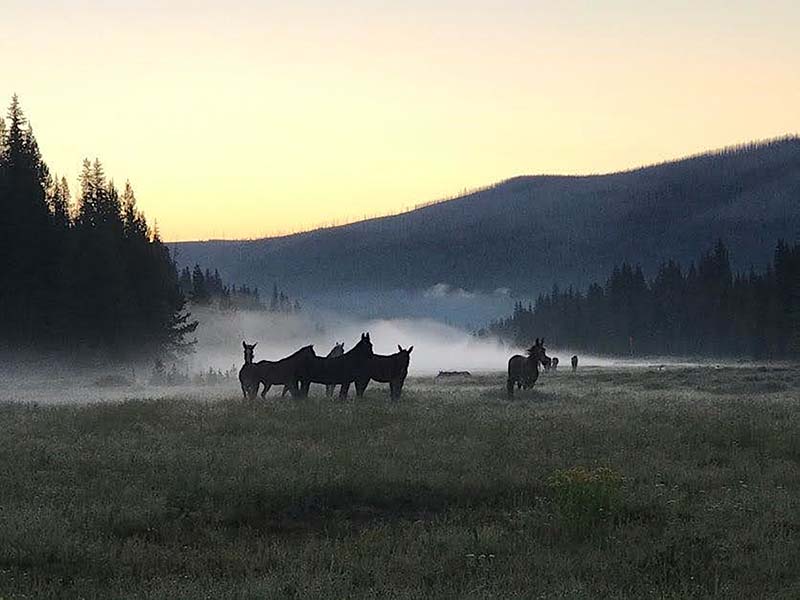
On a high trail in the Selway-Bitterroots.
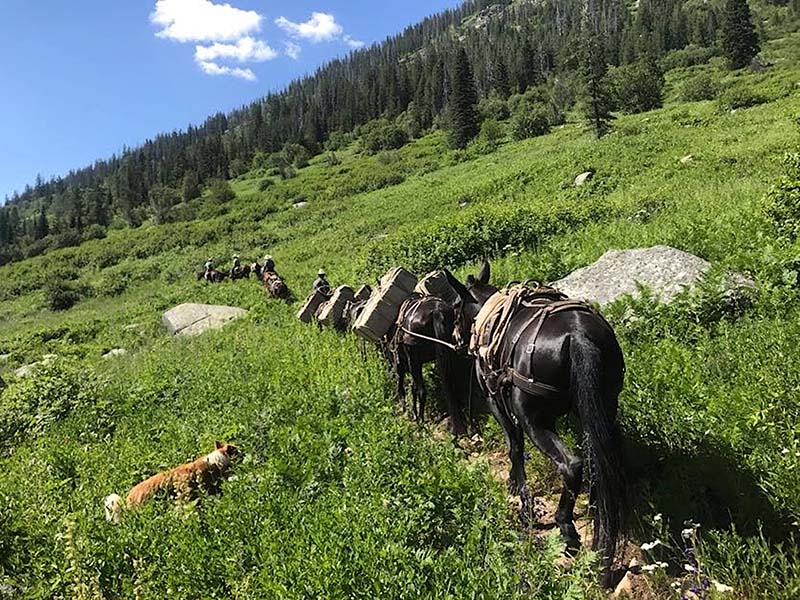
The author's father mowing at Moose Creek.
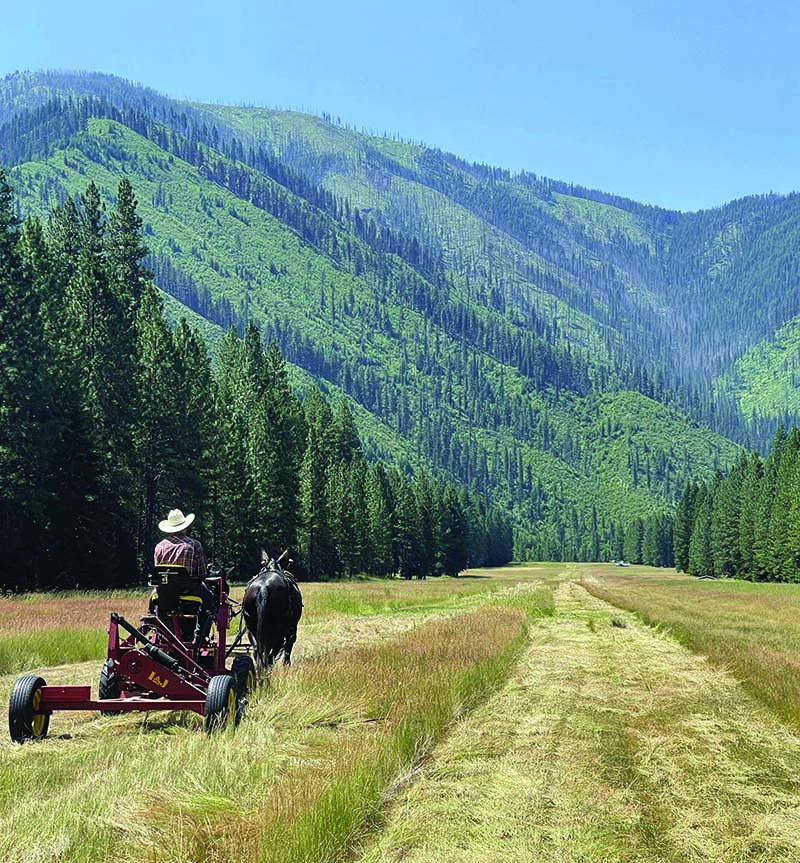
The pack string follows the river.
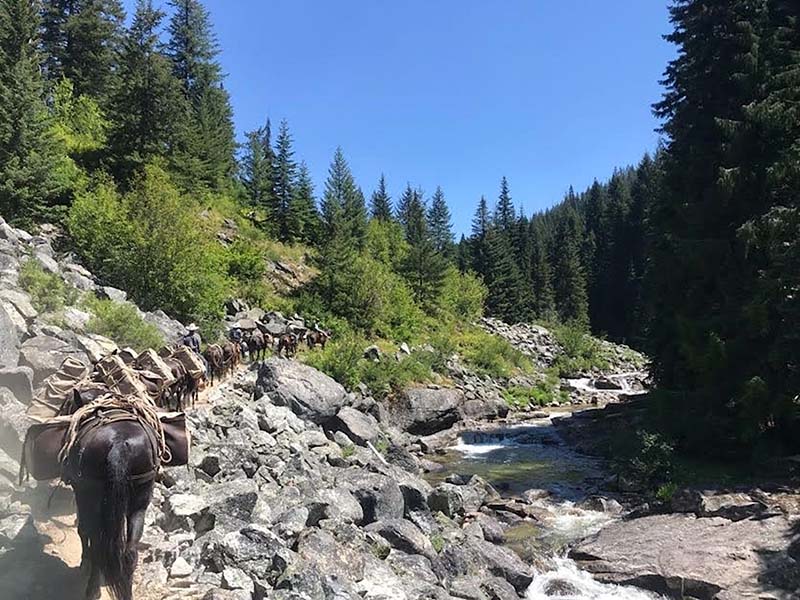
Nice view for the animals.

My mom and brother continue to spend July there, although summer jobs have shortened my stays to just a few days. We backpacked in only on the first trip. The rest were by horse and mule, using our personal stock. But this trip in 2022 is on official Forest Service business, part of my dad’s job, and we have a string of Forest Service animals. Our total count is nine: two horses to ride and seven mules to carry the packs.
The pack loads are made up on a loading dock, which is a weathered platform roughly one hundred by thirty feet. The making of a pack load is a little-known art form. You start with a random assortment of food, personal gear, tools, and whatever else—propane tanks, lumber, building materials, trail crew resupplies, mail—that needs to go.
The pile is then divided among, and crammed into, pairs of wooden pack boxes. The finished pairs must be well-balanced, compact, and nearly identical in weight. An experienced packer like my dad can tell the difference between boxes just by lifting them. Less experienced packers, like me, use a hanging scale.
If all the gear is divided and packed and there is still a weight difference, a rock may be used to add weight. After all the stuff is in the boxes, we have to ensure that it doesn’t come out. Each box is carefully wrapped in a canvas cover, called a manty, and tied up with a rope. A well-made load is a pleasing sight.
My dad and I had made most of the loads the day before, and the pack boxes now stand in pairs on the edge of the dock, waiting for the mules. The little personal gear we have left goes into panniers, canvas bags that hang from the saddle. They don’t require as much skill to pack, and we finish quickly. It’s dark when we begin, but soon the first gray light appears. The sky is clear and the air is still cool, although I know the heat will come. There’s no avoiding it on a mid-July day in a river canyon.
When the loads are ready, we walk to the corrals to catch and saddle the stock. A row of big heads and long ears protruding over the fence greets us, and as we get closer one of the mules lets out a long, loud bray. Horses and mules are intelligent animals.
These ones know there’s a long day ahead, but they also know they’ll get oats at the beginning and green grass at the end. Hence the bray. When we slip through the gate, the herd pushes and crowds around us, sometimes kicking and nipping at each other.
To an inexperienced person, the thought of entering a corral with rowdy one-thousand-pound animals is probably terrifying. With us, though, the animals know their limits, and we catch them all without trouble. Once they’re tied to the hitching rail, my dad moves down the line with a bucket of oats, dumping feed into each pan.
Some animals nicker softly when he’s nearby and others paw in impatience. Like a person, each horse and mule has its own personality, and the packer’s responsibility is to understand each one. If not, troubles arise.
My dad has been working with horses and mules for more than twenty-five years, and he’s traveled many miles with these particular ones. He understands them, which shows in his relationship with them. There’s a certain unnamable quality—gentleness, perhaps, or humility— in his attitude when he’s around them, a certain way he moves and talks to them. In the animals, there’s a look in their eyes and body, an expression of trust and confidence. It’s beautiful to see, and these words don’t do it justice.
I don’t have the experience to replicate my dad’s skills, but I do my best as I move down the row, brushing each animal with a curry comb and talking softly to them. After brushing comes saddling, and the two of us make the work go quickly. When the mules have finished their breakfast, we lead them down to the loading dock for the final stage.
Loading the mules is the bow that ties everything else together. One by one, we move down the line, lifting the heavy boxes onto the mules and supporting them with our chests as we tug, tighten, and tie ropes to hold them in place. The average box weighs about fifty pounds but some are close to one hundred. The end result of our effort is two lines of mules strung head to tail, carrying neatly wrapped and balanced boxes.
On this trip, we have two mules that are new to packing. Dad will lead them, while I’ll lead the remaining five well-seasoned animals. We take our respective strings and swing into our saddles. The first mile of the ride is a little hectic, as usual. Hooves crunch loudly on the gravel trailhead from the guard station and the width of the road makes it difficult to keep the mules in line.
Everything changes once we hit the actual trail, though. The hoofbeats become quieter, the mules settle into line, and the atmosphere becomes less charged. I settle in, too, for twenty-five miles of trail-riding.
Time and distance flow at the pace of a pack string, three miles per hour. I judge how far we’ve traveled by the creeks we cross, their names long ago inscribed in my memory. At three miles in, we stop to check packs, tighten ropes, and make any needed readjustments. As we move down the trail again, a part of me remains attentive to the animals.
I’m constantly aware of the movement and rhythm of my horse beneath me, and I regularly look over my shoulder to see how the mules are faring. The regular hoofbeats and snorts provide comforting background noise. Meanwhile, the rest of my mind is free to wander, contemplate, and enjoy the beauty surrounding me.
The river speaks from below the trail, alternating between the shouts of a rapid, the murmurings of a riffle, and the quiet contemplation of a deep pool. The sides of the canyon are covered with forests of Douglas fir, grand fir, ponderosa pine, and cedar, as well as syringa, mountain ash, and serviceberry. The wind carries a cacophony of scents: trees, plants, river, and earth mingle with the ever-present smells of equines. Life is fine.
Miles go by. It’s now afternoon, and the coolness of the morning has long been replaced by the glare of the sun. A patch of shade or a slight breeze brings only small relief. The trail stays high above the river and becomes steeper and rockier. Dusty, too. It coats my nose and mouth. Sweat dampens the back of my shirt and my hatband.
The animals are hot as well—I can feel my horse’s sweat soaking the back of my pants where my calf rubs against his side, and the smell of equine sweat grows stronger. Still, the only way out is through, and we continue.
At last we reach Divide Creek, a favorite swimming hole of ours when we’re at Moose Creek. It marks the beginning of the end. After another half-mile we cross Moose Creek itself on a wooden cable bridge that sways slightly with the movement of the animals. A final climb puts us at the end of the airstrip.
The last mile of the trail circles around the airstrip through a cool, shady forest. The animals pick up the pace slightly, knowing the end is near. We emerge from the forest and enter the compound at the barn.
My mom and brother are waiting for us. We slide off our horses, stiff at first after nine hours on the trail. We greet our family briefly, but right now the animals have priority. We limber up as we work to tie the mules to the hitching rack. Together, we untie the packs and set them on the loading dock, and then we unsaddle. Finally, we turn each horse and mule loose in the corral with a pat on the neck and a whispered, “Good job today.”
Every one does the same thing upon release. First, they lie down to roll in the dust, kicking their legs and heaving themselves from one side to the other. The dust helps them cool off and relieve the irritation caused by the sweat. Afterwards, they get back on their feet, shake, and go to the water trough for a drink. Their work is done, for now.
Our work is done too—the hard part, anyway. The pack boxes are unwrapped and stacked neatly against the wall, the ropes coiled, manties folded, and contents moved by wheelbarrow to their place on the compound. Then we can relax in the cookhouse. We take off our boots, sip cold glasses of lemonade, and talk.
Later on, after dinner is eaten and the dishes cleaned, we’ll walk over to the corral and let the stock out onto the airstrip for the night. They stand waiting for us patiently (or not, in some cases). Regardless of how long the day was, at least one animal always rushes out kicking and bucking in delight. This never fails to bring a smile to my face.
In the coolness of the evening, I sit on the wooden crossbuck fence and take in the view. The sky is a light pink, and a few wispy golden clouds drift along. The moon, just under half-full, peeks out from behind a ridge. Evening gives everything a soft look, with shapes blurring into indistinction as the eye moves farther out.
On the airstrip, the horses and mules graze peacefully, tails swishing, feet stomping, mouths grinding. The birds have all gone to bed, but in the distance I can hear a squirrel chattering. Why, I don’t know. Perhaps it was disturbed by the movements of a deer or bear on the ground.
As night falls, crickets begin to chirp, their symphony filling the air. A light breeze moves up the canyon, shaking branches and swaying treetops. It carries a breath of cool air, a prelude to a cold front moving in, perhaps. It would be a welcome relief from the heat.
A sense of peace and calm comes over me. My mind wanders back over the years, reliving the many weeks I’ve spent here at Moose Creek. Horses, mules, rivers, and trails flow through my mind. It’s a good end to another good day.
If you enjoyed this story, please consider supporting us with a SUBSCRIPTION to our print edition, delivered monthly to your doorstep.
This content is available for purchase. Please select from available options.
Purchase Only
Purchase Only

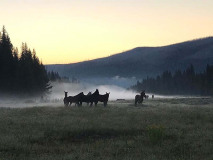
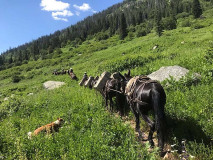
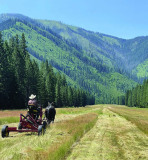
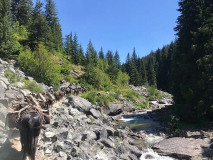
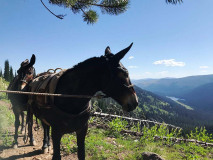
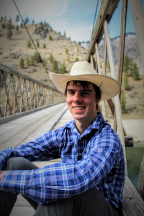
7 Responses to Two Horses, Seven Mules
Stan Barnhart -
at
Mighty fine writing of shared intimacy with Idaho’s splendid backcountry.
Thanks for your shared gift.
Grant Miles -
at
Awesome Levi I really enjoyed this, next to being there..
Kay Brent -
at
Wonderful story. Reminded me of my backpacking, camping trips with my family in north central Idaho. Your writing made me feel like I was there.
Bonnie Patrick -
at
Levi..I remember one trip into fish lake with you and your family and the team to mow the airstrip..your article brought back the sounds, and he smells the wonderful feelings..great writing..great kid
Jerry VanHavel -
at
Levi,
This is very well written. I have been to Moose Creek with my daughter, in fact, your father taught her how to pack and care for stock. Thanks for bestowing this skill to her. You have been blessed with a unique childhood and surrounded by all the wonder of the wilds, I understand this has not been lost on you. I hope your life trail will be as fulfilling and special as your time in Moose Creek.
Jerry VanHavel
Terry Baddley -
at
Thanks for the fine article. Brought back memories of the pack trips into the heart of the Selway-Bitterroot during the 1985-95 period of my life. No finer country to be seen from the back of a horse!
G Edward Ingram -
at
I don’t know what you’re studying in college but don’t ever give up writing. Good story, well written.